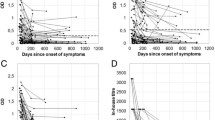Abstract
Shiga-like toxin-producingEscherichia coli O157:H7 are important causes of bloody diarrhea and hemolytic uremic syndrome. To facilitate the epidemiologic study of these organisms, we developed enzyme-linked immunosorbent assays (ELISAs) for antibodies to Shiga-like toxin I (SLT I), Shiga-like toxin II (SLT II), andE. coli O157 lipopolysaccharide (LPS). We tested serum samples from 83 patients in two outbreaks ofE. coli O157:H7 diarrhea and from 66 well persons. Forty-three patients (52%) had at least one serum sample positive for anti-O157 LPS antibodies; among 26 culture-confirmed patients, 24 (92%) had at least one positive serum sample. Two (3%) of 66 control sera had positive anti-O157 LPS titers. ELISA results for SLT I and II were compared with those of HeLa cell cytotoxicity neutralization assays on both patient and control sera. Neutralization assays detected anti-SLT I antibodies in at least one serum sample from each of 17 (20%) patients and 7 (10.6%) controls, while 16 (19%) patients and 7 controls had positive titers by anti-SLT I ELISA. Although all serum samples, including control sera, showed nonspecific neutralization of SLT II, no antibody titers to SLT II were detected by either neutralization or ELISA. These results indicate that ELISAs for SLT I and SLT II antibodies are comparable to HeLa cell cytotoxicity neutralization assays. Both the ELISAs and neutralization assays are insensitive in detecting infected patients. However, the ELISA for antibodies toE. coli O157 LPS is both sensitive and specific, and may be more useful than assays for antitoxic antibodies in detecting persons withE. coli O157:H7 infection.
Similar content being viewed by others
Literature Cited
Bopp CA, Greene KD, Downes FP, Sowers EG, Wells JG, Wachsmuth IK (1987) Unusual Verotoxin-producingEscherichia coli associated with hemorrhagic colitis. J Clin Microbiol 25:1486–1489
Centers for Disease Control (1986) Thrombotic thrombocytopenic purpura associated withEscherichia coli O157:H7. Washington, DC: Morbid Mortal Weekly Rep 35:549–551
Chart H, Scotland SM, Rowe B (1989) Serum antibodies toEscherichia coli serotype O157:H7 in patients with hemolytic uremic syndrome. J Clin Microbiol 27:285–290
Chart H, Smith HR, Scotland SM, Rowe B, Milford DV, Taylor CM (1991) Serological identification ofEscherichia coli O157:H7 infection in haemolytic uraemic syndrome. Lancet 337:138–140
Cohen A, Madrid-Marina V, Estrov Z, Freedman MH, Lingwood CA, Dosch H-M (1990) Expression of glycolipid receptors to Shiga-like toxin on human B lymphocytes: a mechanism for the failure of long-lived antibody response to dysenteric disease. Int Immunol 2:1–8
Downes FP, Barrett TJ, Green JH, Aloisio CH, Spika JS, Strockbine NA, Wachsmuth IK (1988) Affinity purification and characterization of Shiga-like toxin II and production of toxin specific monoclonal antibodies. Infect Immun 56:1926–1933
Gentry MK, Dalrymple JM (1980) Quantative microtiter assay forShigella toxin. J Clin Microbiol 12:361–366
Griffin PM, Ostroff SM, Tauxe RV, Greene KD, Wells JG, Lewis JH, Blake PA (1988) Illness associated withEscherichia coli O157:H7 infections. A broad clinical spectrum. Ann Intern Med 109:705–712
Head SC, Karmali MA, Roscoe ME, Petric M, Strockbine NA, Wachsmuth IK (1988) Serological differences between verocytotoxin 2 and Shiga-like toxin II. Lancet ii:751
Jackson MP, Neil RJ, O'Brien AD, Holmes RK, Newland JW (1987) Nucleotide sequence analysis and comparison of the structural genes for Shiga-like toxin I and Shiga-like toxin II encoded by bacteriophages fromEscherichia coli 933. FEMS Microbiol Lett 44:109–114
Jackson MP, Newland JW, Holmes RK, O'Brien AD (1987) Nucleotide sequence analysis of the structural genes for Shiga-like toxin I encoded by bacteriophage 933J fromEscherichia coli. Microb Pathog 2:147–153
Karmali MA (1989) Infection by Verocytotoxin-producingEscherichia coli. Clin Microbiol Rev 2:15–38
Karmali MA, Petric M, Lim C, Fleming PC, Arbus GS, Lior H (1985) The association between idiopathic hemolytic uremic syndrome and infection by Verotoxin-producingEscherichia coli. J Infect Dis 151:775–782
Newland JW, Neil RJ (1988) DNA probes for Shiga-like toxins I and II and for toxin-converting bacteriophages. J Clin Microbiol 26:1292–1297
O'Brien AD, Holmes RK (1987) Shiga and Shiga-like toxins. Microbiol Rev 51:206–220
Ostroff SM, Griffin PM, Tauxe RV, Shipman LD, Greene KD, Wells JG, Lewis JH, Blake PA, Kobayashi JM (1990) A statewide outbreak ofEscherichia coli O157:H7 infections in Washington State. Am J Epidemiol 132:239–247
Pavia AT, Nichols CR, Green DP, Tauxe RV, Mottice S, Greene KD, Wells JG, Siegler RL, Brewer ED, Hannon D, Blake PA (1990) Hemolytic-uremic syndrome during an outbreak ofEscherichia coli O157:H7 infections in institutions for mentally retarded persons: clinical and epidemiologic observations. J Pediatr 116:544–551
Riley LW (1987) The epidemiologic, clinical, and microbiologic features of hemorrhagic colitis. Annu Rev Microbiol 41:383–407
Riley LW, Remis RS, Helgerson SD, McGee HB, Wells JG, Davis BR, Hebert RJ, Olcott HM, Johnson LM, Hargrett NT, Blake PA, Cohen ML (1983) Hemorrhagic colitis associated with a rareEscherichia coli serotype. N Engl J Med 308:681–685
Scotland SM, Smith HR, Rowe B (1985) Two distinct toxins active on Vero cells fromEscherichia coli O157. Lancet ii:885–886
Scotland SM, Rowe B, Smith HR, Wilshaw GA, Gross RJ (1988) Verocytotoxin-producing strains ofEscherichia coli from children with HUS and their detection by specific DNA probes. J Med Microbiol 25:237–243
Smith HR, Rowe B, Gross RJ, Fry NK, Scotland SM (1987) Haemorrhagic colitis and Verocytotoxin producingEscherichia coli in England and Wales. Lancet i:1062–1064
Strockbine NA, Marques LRM, Holmes RK, O'Brien AD (1985) Characterization of monoclonal antibodies against Shiga-like toxin fromEscherichia coli. Infect Immun 50:695–700
Strockbine NA, Marques LRM, Newland JW, Smith HW, Holmes RK, O'Brien AD (1986) Two toxin-converting phages fromEscherichia coli O157:H7 strain 933 encode antigenically distinct toxins with similar biologic activities. Infect Immun 53:135–140
Strockbine NA, Jackson MP, Sung LM, Holmes RK, O'Brien AD (1988) Cloning and sequencing of the genes for Shiga toxin fromShigella dysenteriae type 1. J Bacteriol 170:1116–1122
Wells JG, Davis BR, Wachsmuth IK, Riley LW, Remis RS, Sokolow R, Morris GK (1983) Laboratory investigation of hemorrhagic colitis outbreaks associated with a rareEscherichia coli serotype. J Clin Microbiol 18:512–520
Author information
Authors and Affiliations
Rights and permissions
About this article
Cite this article
Barrett, T.J., Green, J.H., Griffin, P.M. et al. Enzyme-linked immunosorbent assays for detecting antibodies to Shiga-like toxin I, Shiga-like toxin II, andEscherichia coli O157:H7 lipopolysaccharide in human serum. Current Microbiology 23, 189–195 (1991). https://doi.org/10.1007/BF02092278
Issue Date:
DOI: https://doi.org/10.1007/BF02092278




